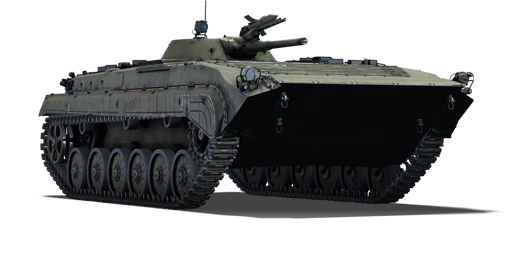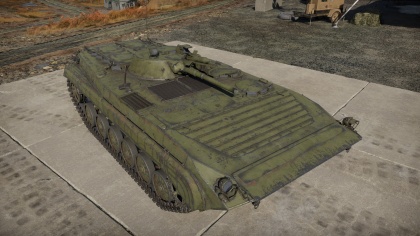ZBD86
Contents
Description
The ZhuangJia BuBing LÜDai 86 is a rank Chinese light tank
with a battle rating of (AB), (RB), and (SB). It was introduced in Update 1.91 "Night Vision". The ZBD86 is a shoot-and-scoot type of vehicle as an exposed ZBD86 is a dead ZBD86 - avoid being a target at all costs. Use your mobility to find reasonable sniping spots (for your ATGM) and only use your cannon if an enemy is close and unaware of your presence. Remember that if anything sees you, it can destroy you - even a .50 cal will make quick work of the ZBD86 from the sides or back.
General info
Survivability and armour
Describe armour protection. Note the most well protected and key weak areas. Appreciate the layout of modules as well as the number and location of crew members. Is the level of armour protection sufficient, is the placement of modules helpful for survival in combat? If necessary use a visual template to indicate the most secure and weak zones of the armour.
The ZBD86 has very little to speak of in the armour department. Minimal frontal and nearly non-existent side armour results in the vehicle being vulnerable to almost any incoming fire. As such, the vehicle's survivability stems entirely from its mobility and reasonably small profile. Where possible, utilise hills or other cover, only exposing as much of the vehicle as is necessary to engage an unaware target.
Despite the lack of armour, however, the ZBD86 will, on occasion, survive hits unexpectedly - the internals of the vehicle are largely non-critical and many rounds will over-penetrate.
Mobility
| Game Mode | Max Speed (km/h) | Weight (tons) | Engine power (horsepower) | Power-to-weight ratio (hp/ton) | |||
|---|---|---|---|---|---|---|---|
| Forward | Reverse | Stock | Upgraded | Stock | Upgraded | ||
| Arcade | Expression error: Unexpected * operator. | 465 | Expression error: Unexpected round operator. | __.__ | |||
| Realistic | 265 | Expression error: Unexpected round operator. | __.__ | ||||
Be aware when attempting flanking maneuvers and early pushes that there are vehicles with better mobility characteristics, and in many cases you'll encounter a vehicle before reaching a desirable position.
Armaments
Main armament
Main article: 2A28 (73 mm)
The 2A28 main cannon, despite being the 'main' armament will more often than not act more as secondary armament, at least once the BMP-1P upgrade is researched, due to the 9M113 ATGM proving significantly more controllable and effective at all engagement ranges. Despite this, the PG-9 HEAT round proves valuable in a pinch, with well-placed shots able to disable critical components on most vehicles the ZBD86 will face. Keep in mind that the ZBD86 does not feature any sort of stabilisation at all, and due to its light weight the gun is near impossible to get on target at speed.
The main cannon's primary drawback is its mediocre ballistic performance, with the HEAT round travelling at only 665 m/s and the HE round travelling at an abysmal 290 m/s.
Additional armament
Some tanks are armed with several guns in one or more turrets. Evaluate the additional weaponry and give advice on its use. Describe the ammunition available for additional weaponry. Give advice on about how to use them and how to fill the ammunition storage. If there is no additional weaponry remove this subsection.
Machine guns
Offensive and anti-aircraft machine guns not only allow you to fight some aircraft but also are effective against lightly armoured vehicles. Evaluate machine guns and give recommendations on its use.
Usage in battles
Describe the tactics of playing in the vehicle, the features of using vehicles in the team and advice on tactics. Refrain from creating a "guide" - do not impose a single point of view but instead give the reader food for thought. Describe the most dangerous enemies and give recommendations on fighting them. If necessary, note the specifics of the game in different modes (AB, RB, SB).
Pros and cons
Summarise and briefly evaluate the vehicle in terms of its characteristics and combat effectiveness. Mark its pros and cons in a bulleted list. Try not to use more than 6 points for each of the characteristics. Avoid using categorical definitions such as "bad", "good" and the like - use substitutions with softer forms such as "inadequate" and "effective".
Pros:
- Fairly mobile, both weapon systems are particularly effective against the lightly armoured vehicles it will encounter often such as the Leopard I, OF-40, etc
- One of the earliest ATGM vehicles available and the earliest to receive mouse-guided (SACLOS) ATGMs (with the BMP-1P modification)
- Decent main gun HEAT round penetrating up to 300mm of armour at any range, effective against last-gen heavy tanks like the Conqueror, M103, etc
- Amphibious ability which can allow it to reach positions that other vehicles struggle to
- Functional even in uptiers, due to its piercing ATGM and HEAT
- All ammunition types are default and as such have no cost
- Night Vision allows effectiveness in night battles
Cons:
- Mediocre reverse speed, particularly for a light tank
- Default missiles are manually guided, upgraded missiles must be unlocked with the BMP-1P research
- Vulnerable to hull breaks, particularly from HEAT-FS rounds
- Chemical ammunition only, may struggle to damage vehicles with ERA like the M60A1 RISE (P)
- All available ammunition is hyper-sensitive and will detonate on hitting light obstacles such as fences or bushes
- Somewhat large silhouette for a light tank. Will get seen and shot at easier
- Minimal gun depression makes it struggle in hills
- Has no stabiliser, accurate shots on the move or in water are often not possible
- Only three crew members, two of whom sit extremely close together, reducing the vehicle's survivability
- Vulnerable to heavy machine gun and light cannon fire, particularly from the sides or top. SPAA like the Gepard are a big threat
- Very vulnerable to aircraft and helicopters
- Bombs and artillery can deal significant damage, even when at a distance
- Infrared Spotlight mounted to hull, won't rotate with turret when NVD is on
History
Development
In the 1950’s, Soviet armored personnel carrier (APC) tactics consisted of lightly armored vehicles that would transport soldiers to combat zones, and then head back behind the lines to safety. During this time, the West German Bundeswehr was using the Schützenpanzer Lang and infantry fighting vehicle (IFV) tactics, where the vehicles would work with the infantry and tanks in order to support them, especially against lightly armored targets. The BMP was a Soviet IFV design created in the late 1950’s. Some of the requirements were the ability for all of the infantry carried to be able to fire from within the vehicle, which was unseen before in IFV designs. It was intended to support the infantry and combat enemy light vehicles. The design placed emphasis on speed and maneuverability, potent armament, and sufficient armament to protect against 23 mm autocannons over the frontal arc. There was a debate over how the vehicle should be wheeled or tracked, and a number of options were explored including hybrid designs with both. The design that was chosen was a tracked vehicle with the engine in the front and the crew compartment in the rear; it was designated the Object 764. A prototype was created in 1964, and the final design was chosen in 1965 - an improved model called the Object 765. In service the production model was called the BMP-1.
Design
The BMP-1 features a fully tracked hull, with a sharply angled glacis at the front, a centrally mounted turret, and a crew compartment in the rear of the hull, with doors for the infantry to mount and dismount the vehicle. The hull layout is as follows: the engine was in the front right section of the hull. The driver sat to the front left of the vehicle, the commander sat right behind the driver, and the gunner sat in the right side of the turret. The troop compartment located at the rear of the vehicle could seat 8 infantry soldiers. The ability to fire from inside the vehicle was provided by four firing ports on each side of the hull and one in the left door. There are also four hatches in the roof. The infantry sit on two benches with padding, back to back, facing the outer sides of the vehicle. The armor of the frontal arc is enough to generally protect against 20 mm autocannon fire, the side armor generally protects against 12.7 mm machine gun fire, and the roof and rear armor protects against small arms fire and shell fragments. In addition, the sloped glacis on the front of the hull also increased the chances of shells bouncing, because of the extreme angles. The protection level depended somewhat on the version of the BMP-1 in question, as different nations had differing levels of armor quality. The main armament consisted of a 73 mm 2A28 Grom smoothbore semi-automatic cannon, along with a 9M14 Malyutka anti-tank guided missile (ATGM). Secondary armament consisted of a 7.62 mm PKT machine gun. The engine provides 300 hp, and is a six-cylinder four-stroke diesel engine. The suspension system used was a torsion bar suspension system. The BMP-1 is fully amphibious with little preparation. Before entering the water a trim vane has to be raised, which provides additional frontal armor when in the lowered position. It can achieve 65 kph (40 mph) on road and 8 kph (5 mph) in water.
Production and Service
Over 20,000 BMP-1's were produced in the Soviet Union alone, with many more produced in China and Czechoslovakia. The BMP-1 was widely exported and saw significant combat worldwide. BMP-1's participated in the Yom Kippur War, the Angolan Civil War, the Iran-Iraq War, the Gulf War, and many other conflicts. It was well liked for its maneuverability, but it was found that the cannon lacked effective range and the 9M14 ATGM's were hard to control. During the Gulf War it was found that the 25 mm Bushmaster cannon found on the M2/M3 Bradley could consistently penetrate the frontal armor of the BMP-1, even at range.
BMP-1P Upgrade
The BMP-1P was an upgrade to the ATGM systems of the BMP-1. It replaced the 9M14 Malyutka missiles with 9M113 Konkurs or 9M111 missile. This increased the weight of the vehicle, leading to a slight decrease in maneuverability.
Chinese Service
China produced their own version of the BMP-1 called the ZBD 86, also known as Type 86. They produced a total of over 3,000 Type 86 vehicles of different variants. Over 1,000 are still in service today.
Media
Excellent additions to the article would be video guides, screenshots from the game, and photos.
See also
Links to the articles on the War Thunder Wiki that you think will be useful for the reader, for example:
- reference to the series of the vehicles;
- links to approximate analogues of other nations and research trees.
Bibliography
- David B. (2015, December 1). BMP-1. Tank Encyclopedia. https://tanks-encyclopedia.com/coldwar/USSR/soviet_BMP-1.php
- BMP-1. (2020, March 25). In Wikipedia. https://en.wikipedia.org/w/index.php?title=BMP-1&oldid=947316322
External links
Paste links to sources and external resources, such as:
- topic on the official game forum;
- encyclopedia page on the tank;
- other literature.
| China light tanks | |
|---|---|
| Type 63 | Object 211 · Type 63 · ZTS63 |
| Type 62 | Type 62 |
| WZ551 | ZSL92 · PTL02 · WMA301 |
| ZBL08 | ZLT11 |
| Type 86 | ZBD86 |
| WZ502 | ZBD04A |
| ROC | M41D · M64 |
| Type 59 | QN506 |
| USA | ␗M8 LAC · ␗M3A3 Stuart · ␗M3A3 (1st PTG) · ␗M5A1 · ␗M24 · ␗M18 GMC · ␗M41A3 |
| USSR | ␗T-26 · T-26 No.531 · ␗PT-76 |





